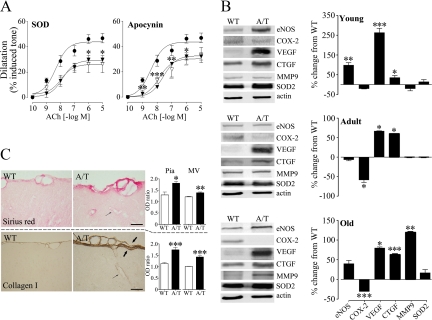Figure 2.
A/T mouse vessels were characterized by resistance to antioxidants, alterations in vascular signaling molecules and cerebrovascular fibrosis. A: The impaired ACh-mediated dilatation of aged A/T (inverted filled triangles) relative to WT mice (circles) was not improved in A/T arteries after in vitro incubation (inverted open triangles) with the O·−2 scavenger SOD or a blocker of its synthesis, apocynin (n = 3–4 mice/group). B: Disturbed levels of vasodilator-synthesizing enzymes, endothelial NOS eNOS and cyclooxygenase-2 (COX-2) and of markers related to vascular remodeling, vascular endothelial growth factor (VEGF), connective tissue growth factor (CTGF), matrix metalloproteinase 9 (MMP-9) but not of the oxidative stress marker SOD2, as measured by Western blot in pial vessels of A/T relative to WT mice. Actin was used to normalize loading variation (n = 3–6 mice/group). C: Collagen accumulation in the pia (thick arrows) and intraparenchymal microvessels (MVs, thin arrows) of 18-month-old A/T relative to WT mice, measured as an optical density (OD) ratio of the vessel intensity to that of adjacent parenchyma in Sirius red-stained (top) and collagen I-immunoreactive (bottom) 5-μm-thick paraffin sections (n = 3–9 mice/group). Scale bar = 20 μm. Error bars represent SEM. *P < 0.05, **P < 0.01, ***P < 0.001 when compared with WT using Student’s t-test or one-way analysis of variance followed by Newman-Keuls posthoc test.

